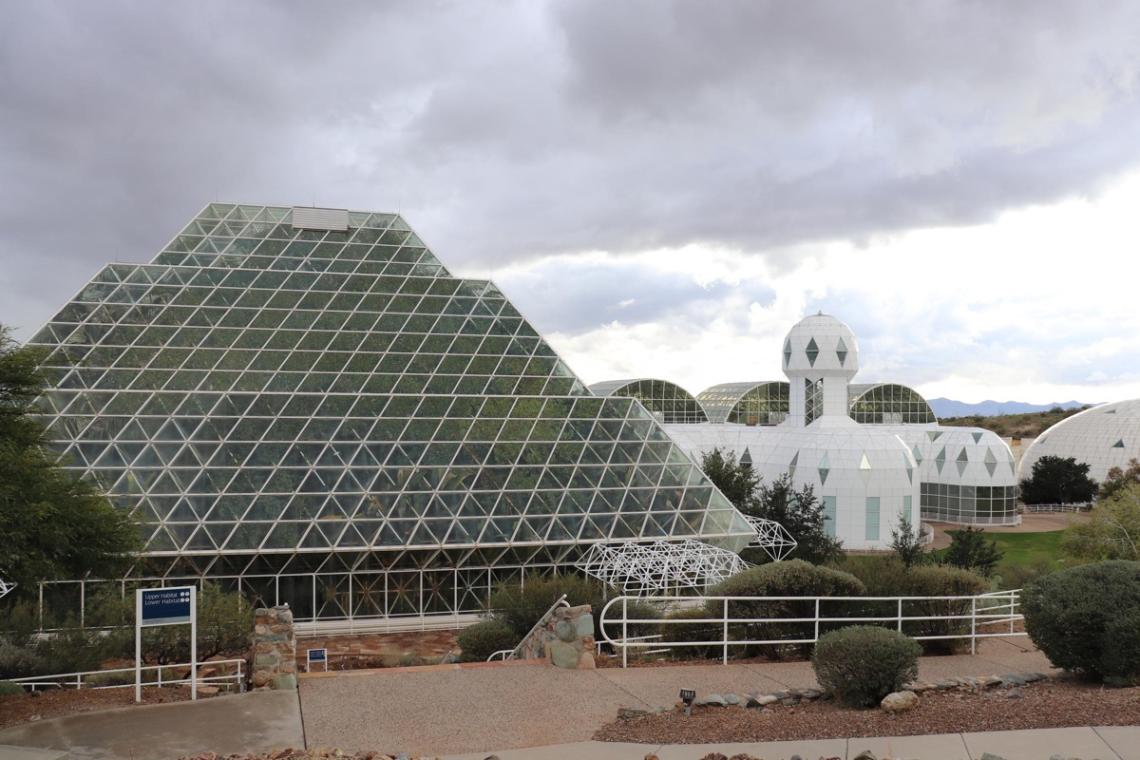Developed by the National Center for Appropriate Technology, the AgriSolar Clearinghouse was launched in November 2021 to connect farmers, ranchers, land managers, solar developers, and researchers with information about co-locating solar and agriculture, otherwise known as agrivoltaics. The AgriSolar Clearinghouse is taking a national tour of operational agrivoltaic operations, sharing knowledge, and bringing attention to a practice with numerous (and perhaps unexpected) benefits.
The clearinghouse features a library of peer-reviewed information, videos, podcasts, news, and a forum for agrivoltaics discussion. More than 30 partners and stakeholders in renewable energy, sustainable agriculture, national energy laboratories, the Smithsonian, and leading universities participated in its creation.
The first stop on the tour is the agrivoltaic array at Biosphere 2, a research center run by the University of Arizona. Biosphere 2 is nothing short of incredible, it is a 3.14-acre laboratory in the middle of the hot, dry Sonoran Desert that is referred to as the world’s largest earth science experiment. Contained inside the massive facility is a climate-controlled environment, complete with ocean, rainforest, mangrove, desert, and savanna-simulating conditions.
Outside the Biosphere is an area with solar PV on raised structures. And below the panels are crops: kale, tomatoes, Swiss chard, and more. The facility is meant to serve a similar function to Biosphere 2, aiding researchers in understanding the various effects climactic conditions create.
Dr. Greg Barron-Gafford, director of food, water, energy research at Biosphere, runs the agrivoltaic system. He uses a portable handheld device equipped with the same climate controls as the Biosphere, which he calls the “mini-Biosphere”, and measures sunlight irradiance, temperature, moisture levels and other climate variables.
When Barron-Gafford started the project he was focused on was challenges with renewable energy production in high-heat conditions. “At the same time, we want to produce food out here in the West, but water resources are becoming more scarce.” Shifting climates have made rainwater less predictable and more intermittent, so water management will become an increasing part of food production.
A simple, but important benefit the Biosphere team found was that the shade provided by the photovoltaic system reduced evaporation, meaning that water would stay on the surface longer and better feed crops than open-air land-based agriculture. Not only does this save water, but it makes the plants grow stronger, leading to a better crop yield. Additionally, the shaded space provided by the panels causes plants to spread out, searching for sunlight. Barron-Gafford shared an example of an open-air leaf versus an agrivoltaic one from the same species of plant, and the agrivoltaic leaf was at least double the size.
The agrivoltaic array has mutual benefits for crop growth and energy production. In dry climates like the one that surrounds Biosphere 2, there can often be too much light and heat for plants to grow properly. The panel’s shade helps create better conditions for the plants. The same goes for solar panels, which produce less power at high temperatures. A conventional solar facility may remove all vegetation below, which, in large solar arrays, causes a studied effect of a heat island.
(Read: “Could agrivoltaics feed our demand for clean energy?”)
Excess sun energy that isn’t converted to electricity can leave the area in two ways: either as latent heat or sensible heat. Sensible heat is the type that we can feel, and the type that is damaging to solar PV production. Latent heat is the energy that is absorbed by nearby water, evaporating into vapor. By adding crops below in a dry climate, you are adding more latent heat absorption, taking heat pressure off the panels, and boosting production and lifecycle.
Dry-climate farmers may enjoy working with agrivoltaics, too. Preliminary data from the center suggests skin temperatures are about 20 degrees Fahrenheit lower than open-air farming.

Image: University of Arizona
“We found that rooftop solar will not be enough for all our energy needs. So you have to move solar into larger chunks, and it costs quite a bit to move that energy around. You don’t want to put it out in complete nowhere. A lot of times you can push it to city edges. And what is in that periurban edge around the cities? That’s where are historic farms are,” said Barron-Gafford.
Barron-Gafford’s team is now exploring ways that food production can be re-introduced into conventional dryland PV arrays.
Research by Oregon State University found that solar and agricultural co-location could provide 20% of the total electricity generation in the United States. Wide-scale installation of agrivoltaics could lead to an annual reduction of 330,000 tons of carbon dioxide emissions while “minimally” impacting crop yield, the researchers said. The paper found that an area about the size of Maryland would be needed if agrivoltaics were to meet 20% of U.S. electricity generation. That’s about 13,000 square miles, or 1% of current U.S. farmland. At a global scale, it is estimated that 1% of all farmland could produce the world’s energy needs if converted to solar PV.
The AgriSolar Clearinghouse is set to continue its journey through the nation’s agrivoltaic centers, making stops in Colorado, Massachusetts, Minnesota, Oregon, New York, and more over the next two years.
“AgriSolar allows us to harvest the sun twice. As America’s appetite for sustainably grown products and renewable energy continues to increase, agrisolar has the potential to provide both resources,” said NCAT Energy Program Director Dr. Stacie Peterson. “The Follow the Sun Tour will visit agrivoltaic sites around the country that are seeing success with things like co-located grazing, habitat rehabilitation, crop production, and cutting-edge research. Our national network of partners includes the world’s leading agrivoltaic experts and we are excited to connect the public with partners like Dr. Greg Barron-Gafford and provide the opportunity to tour his research sites.”
This content is protected by copyright and may not be reused. If you want to cooperate with us and would like to reuse some of our content, please contact: editors@pv-magazine.com.









By submitting this form you agree to pv magazine using your data for the purposes of publishing your comment.
Your personal data will only be disclosed or otherwise transmitted to third parties for the purposes of spam filtering or if this is necessary for technical maintenance of the website. Any other transfer to third parties will not take place unless this is justified on the basis of applicable data protection regulations or if pv magazine is legally obliged to do so.
You may revoke this consent at any time with effect for the future, in which case your personal data will be deleted immediately. Otherwise, your data will be deleted if pv magazine has processed your request or the purpose of data storage is fulfilled.
Further information on data privacy can be found in our Data Protection Policy.